Hi,
I travel quite a bit and often carry solar panels, batteries and controllers with me to set up temporary power at locations with no grid power.
What I am looking for is data that can remove the guesswork and give me actual data that shows the expected average maximum solar energy available for harvest by Month and by Geographic location in kWh per square meter. This might be a bit much to ask but I was wondering if any such data exists.
Is this the best and most accurate data available?
Thanks
I travel quite a bit and often carry solar panels, batteries and controllers with me to set up temporary power at locations with no grid power.
What I am looking for is data that can remove the guesswork and give me actual data that shows the expected average maximum solar energy available for harvest by Month and by Geographic location in kWh per square meter. This might be a bit much to ask but I was wondering if any such data exists.
Is this the best and most accurate data available?
Thanks

Comment